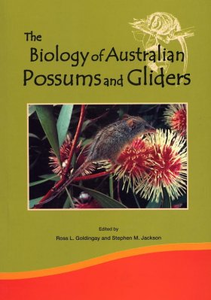Possums and gliders of north Queensland: distribution and conservation status
Winter, John W., Dillewaard, Hans A., Williams, Stephen E., and Bolitho, Elizabeth E. (2004) Possums and gliders of north Queensland: distribution and conservation status. In: Goldingay, Ross L., and Jackson, Stephen M., (eds.) The Biology of Australian Possums and Gliders. Surrey Beatty & Sons, Chipping Norton, NSW, Australia, pp. 26-50.
|
PDF (Published Version)
- Published Version
Restricted to Repository staff only |
||
![[img]](https://researchonline.jcu.edu.au/1680/2.hassmallThumbnailVersion/1680_Winter_et_al_2004.jpg)
|
Image (JPEG) (Front Cover)
- Cover Image
Download (24kB) |
Abstract
A regional resource inventory forms the basis of conservation management. This chapter examines the distribution of possums and gliders within the five most northerly bioregions of Queensland using point data and the DOMAIN bioclimatic modelling technique. The Wet Tropics and Cape York Peninsula are the only bioregions to have been surveyed at a bioregional scale, the former more thoroughly than the latter. Einasleigh Uplands has been the subject of some intensive surveys, but not in a bioregional context. The few possum records from the North West Highlands are concentrated in the northern part, while those from the Gulf Plains are limited to an upland isolate at the southern end of the Gregory Range. Species richness of up to 11 species per km2 is based on predicted core climatic envelopes for each species. Extensions of known geographical range are predicted are predicted for woodland possums along a Wet Tropics/Einasleigh Uplands/Gulf Plains gradient and into the south-west of Cape York Peninsula. Suitable climate and habitat exists for the rock ringtail possum south-east of its present known range and for the endangered mahogany glider south of Cairns, about 90 km north of its presently known range. For rainforest species, the green ringtail possum needs confirming north of the Daintree River. Potentially suitable climate and habitat exists for the long-tailed pygmy-possum on the summit zone of the McIlwraith Range. An assessment of conservation status identifies the need to review this for several species. The status of the yellow-bellied glider within the Wet Tropics may need changing from Vulnerable to Endangered. The isolated Gregory Range population of the greater glider may require classifying as either Rare or Vulnerable. The four upland rainforest possums endemic to the Wet Tropics, the lemuroid ringtail possum, Herbert River ringtail possum, Daintree River ringtail possum and the green ringtail possum are threatened by global warming which will progressively worsen their status from Rare. The present status of Common for most woodland species could be optimistic because two, the common brushtail possum and common ringtail possum, appear to have suffered significant population declines. The rock ringtail is vulnerable to local extinctions of population isolates, and little is known about the population viability of the sugar, squirrel and feathertail gliders.
| Item ID: | 1680 |
|---|---|
| Item Type: | Book Chapter (Research - B1) |
| ISBN: | 978-0-949324-96-2 |
| Keywords: | possums, gliders, north Queensland, wet tropics, species status, resource inventory, conservation |
| Date Deposited: | 03 Oct 2007 |
| FoR Codes: | 06 BIOLOGICAL SCIENCES > 0608 Zoology > 060899 Zoology not elsewhere classified @ 100% |
| SEO Codes: | 97 EXPANDING KNOWLEDGE > 970106 Expanding Knowledge in the Biological Sciences @ 100% |
| Downloads: |
Total: 538 Last 12 Months: 6 |
| More Statistics |



